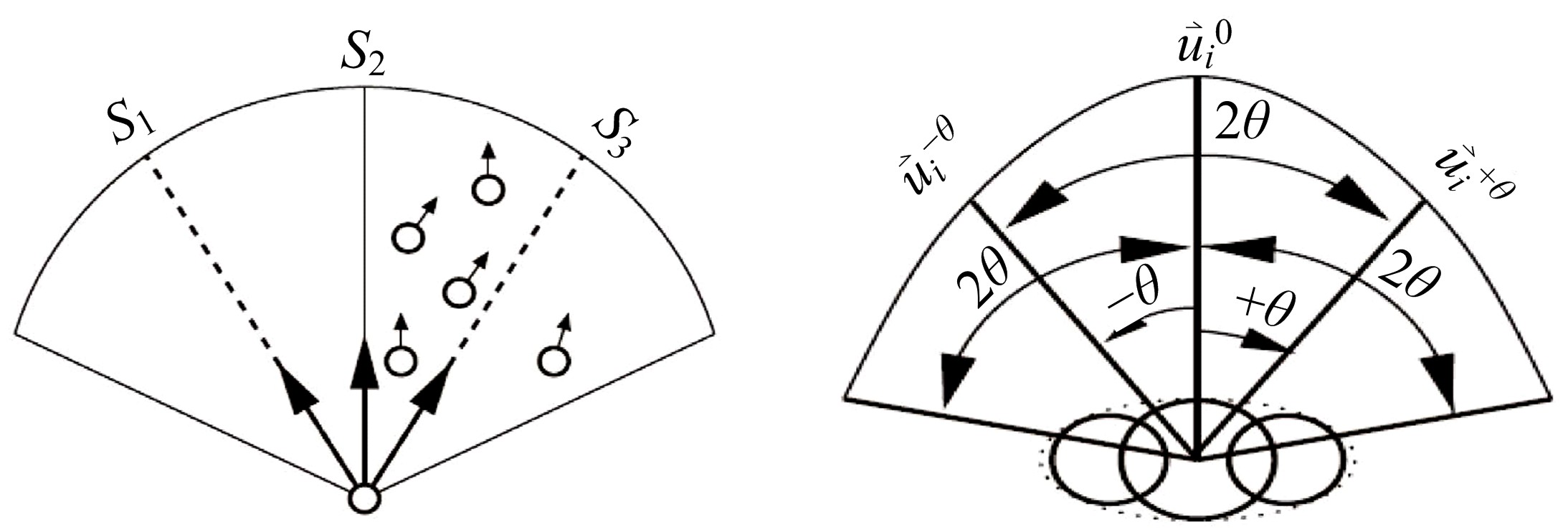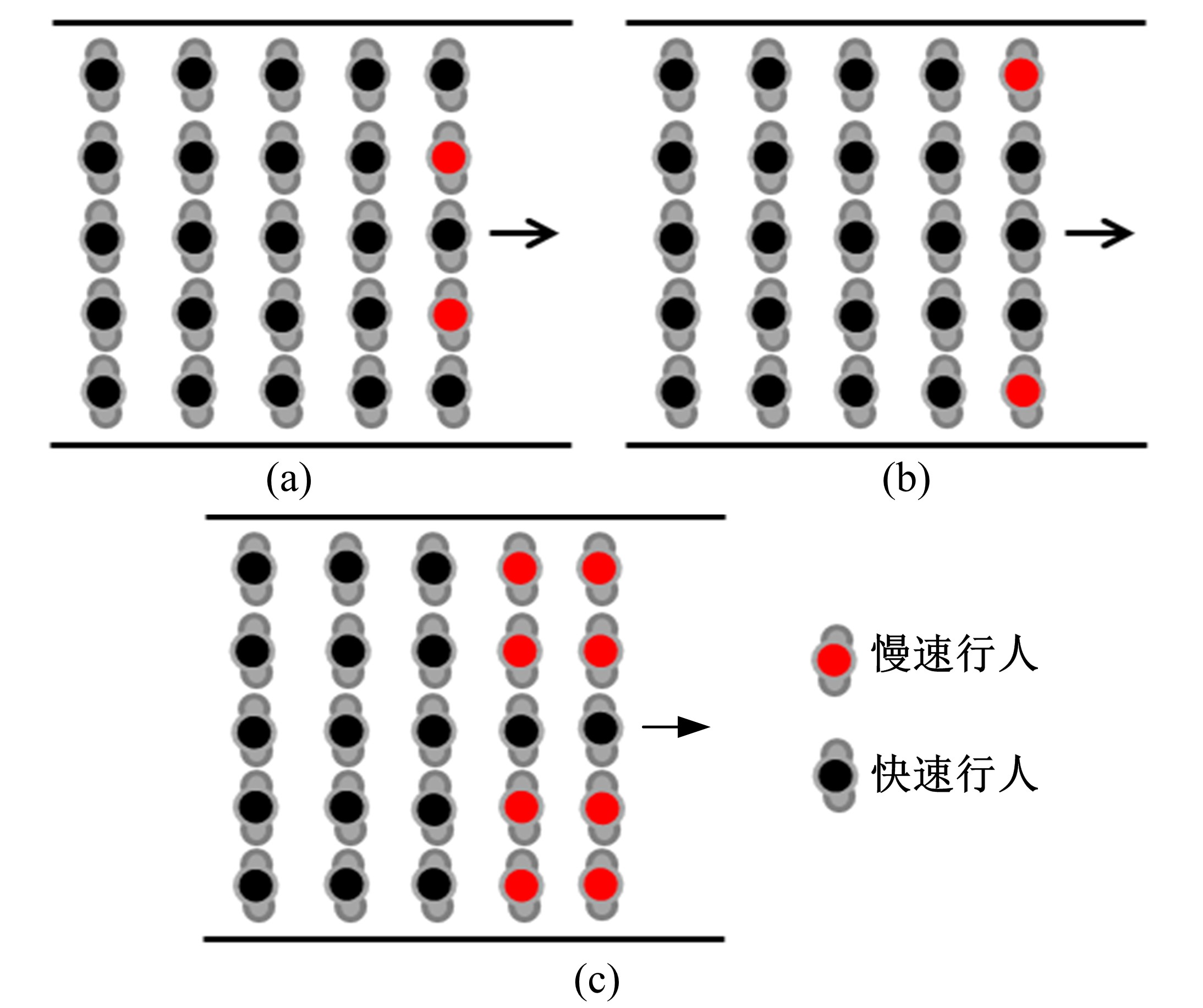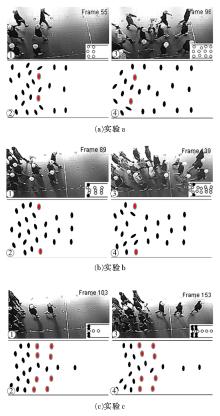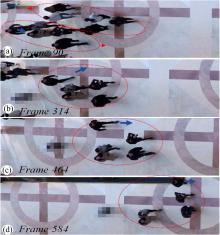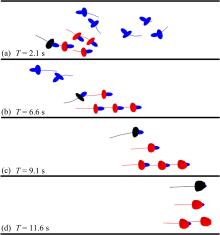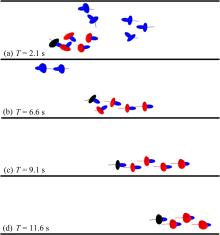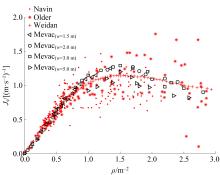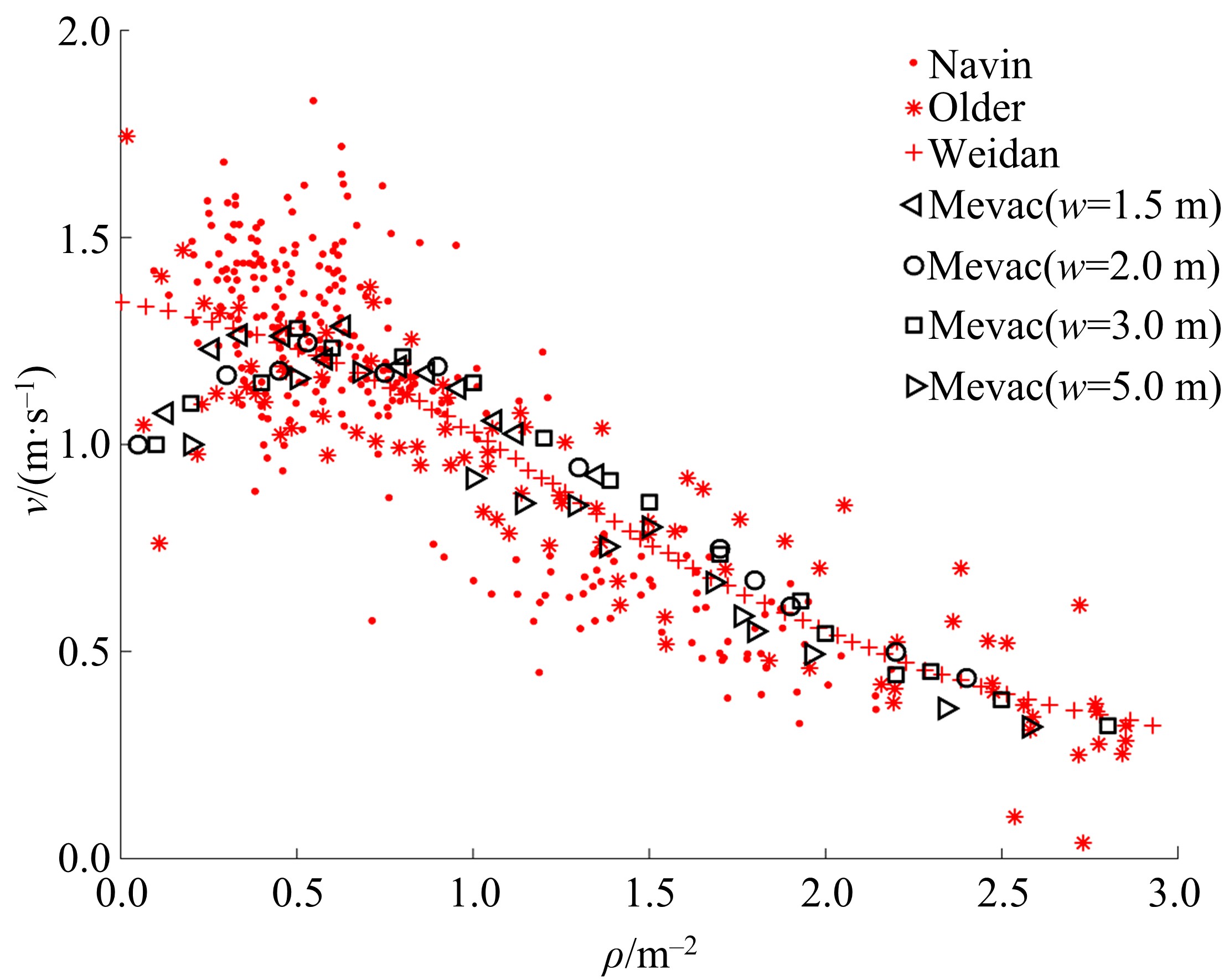吉林大学学报(工学版) ›› 2020, Vol. 50 ›› Issue (2): 549-556.doi: 10.13229/j.cnki.jdxbgxb20181163
• 交通运输工程·土木工程 • 上一篇
考虑行人差异性的人群疏散最优决策理论模型
- 1.哈尔滨工程大学 机电工程学院,哈尔滨 150001
2.哈尔滨工程大学 船舶工程学院, 哈尔滨 150001
An optimization⁃based evacuation model considering pedestrian heterogeneity
Da-wei ZHANG1( ),Hai-tao ZHU1,2
),Hai-tao ZHU1,2
- 1.College of Mechanical and Electrical Engineering, Harbin Engineering University, Harbin 150001, China
2.College of Shipbuilding Engineering, Harbin Engineering University, Harbin 150001, China
摘要:
为研究人群在疏散过程中的行为差异性特征,提出了基于最优决策理论的行人疏散模型,模型引入行人“视觉区域”和差异性个体对空间可利用率的不同敏感度,通过建立空间可利用率评估标准和基于社会“交通规范”的行走方向偏好机制,描述个体在行为和决策层面上的差异性特征。本文对人群实验中异性单向人群和异性对流人群中的超越行为、对流人群渠化现象和对流人群渠化的相变过程进行了仿真,并通过与其他模型仿真结果的对比和人群基本关系图的研究对该模型进行了定性和定量验证。结果显示:该模型在异性人群动力学仿真方面有较好的适用性,可为紧急事故中异性人群安全疏散过程的疏导和人群管理提供合理、有效的建议。
中图分类号:
- U491
| 1 | 马剑, 王若成, 邱谦谦. 紧急情况下城市轨道隧道客流疏散配流模型研究[J]. 铁道学报, 2016, 38( 6): 8- 14. |
| Ma Jian, Wang Ruo-cheng, Qiu Qian-qian. Passenger assignment model for emergency evacuation in metro rail tunnels[J]. Journal of the China Railway Sciety, 2016, 38( 6): 8- 14. | |
| 2 | 岳昊, 何栋梁, 张滨雅, 等. 行人步行设施空间疏散特征指标[J]. 哈尔滨工业大学学报, 2017, 49( 9): 17- 24. |
| Yue Hao, He Dong-liang, Zhang Bin-ya, et al. Spatial characteristics indexes of pedestrian walking facilities for evacuation[J]. Journal of Harbin Institute of Technology, 2017, 49( 9): 17- 24. | |
| 3 | Helbing D, Molnar P. Social force model for pedestrian dynamics[J]. Physical Review E, 1995, 51( 5): 4282- 4286. |
| 4 | Hoogendoorn S P, Bovy P H L. Dynamic user-optimal assignment in continuous time and space[J]. Transportation Research Part B: Methodological, 2004, 38( 7): 571- 592. |
| 5 | 苏书杰, 何露. 步行交通规划交叉路口行人瞬时动态拥塞疏散模型[J]. 吉林大学学报: 工学版, 2018, 48( 2): 440- 447. |
| Su Shu-jie, He Lu. Transient dynamic congestion evacuation model of pedestrian at walk traffic planning crossroads[J]. Journal of Jilin University (Engineering and Technology Edition), 2018, 48( 2): 440- 447. | |
| 6 | 周继彪, 陈红, 闫彬, 等. 基于云模型的地铁换乘枢纽拥挤度辨识方法[J]. 吉林大学学报: 工学版, 2016, 46( 1): 100- 107. |
| Zhou Ji-biao, Chen Hong, Yan Bin, et al. Identification of pedestrian crowding degree in metro transfer hub based on normal cloud model[J]. Journal of Jilin University (Engineering and Technology Edition), 2016, 46 ( 1): 100- 107. | |
| 7 | Smith A, James C, Jones R, et al. Modelling contra-flow in crowd dynamics DEM simulation[J]. Safety Science, 2009, 47( 3): 395- 404. |
| 8 | Parisi D R, Gilman M, Moldovan H. A modification of the social force model can reproduce experimental data of pedestrian flows in normal conditions[J]. Physica A: Statistical Mechanics and its Applications, 2009, 388( 17): 3600- 3608. |
| 9 | Heliövaara S, Korhonen T, Hostikka S, et al. Counterflow model for agent-based simulation of crowd dynamics[J]. Building and Environment, 2012, 48( 1): 89- 100. |
| 10 | Zhang D, Zhu H, Du L, et al. An optimization-based overtaking model for unidirectional pedestrian flow[J]. Physics Letters A, 2018, 382( 44): 3172- 3180. |
| 11 | Yuen J K K, Lee E W M. The effect of overtaking behavior on unidirectional pedestrian flow[J]. Safety Science, 2012, 50( 8): 1704- 1714. |
| 12 | Moussaïd M, Nelson J D. Simple heuristics and the modelling of crowd behaviours[C]∥ Pedestrian and Evacuation Dynamics 2012, Cham: Springer, 2014: 75- 90. |
| 13 | Moussaïd M, Helbing D, Theraulaz G. How simple rules determine pedestrian behavior and crowd disasters[J]. Proceedings of the National Academy of Sciences, 2011, 108( 17): 6884- 6888. |
| 14 | Saberi M, Aghabayk K, Sobhani A. Spatial fluctuations of pedestrian velocities in bidirectional streams: exploring the effects of self-organization[J]. Physica A: Statistical Mechanics and its Applications, 2015, 434: 120- 128. |
| 15 | Tao Y, Dong L. Investigation on lane-formation in pedestrian flow with a new cellular automaton model[J]. Journal of Hydrodynamics, 2016, 28( 5): 794- 800. |
| 16 | Nagatani T. Freezing transition in bi-directional CA model for facing pedestrian traffic[J]. Physics Letters A, 2009, 373( 33): 2917- 2921. |
| 17 | Li X, Guo F, Kuang H, et al. Effect of psychological tension on pedestrian counter flow via an extended cost potential field cellular automaton model[J]. Physica A: Statistical Mechanics and its Applications, 2017, 487: 47- 57. |
| 18 | Fu L, Song W, Lyu W, et al. Simulation of emotional contagion using modified SIR model: a cellular automaton approach[J]. Physica A: Statistical Mechanics and its Applications, 2014, 405: 380- 391. |
| 19 | Batty M. Predicting where we walk[J]. Nature, 1997, 388( 6637): 19- 20. |
| 20 | Feliciani C, Nishinari K. An improved cellular automata model to simulate the behavior of high density crowd and validation by experimental data[J]. Physica A: Statistical Mechanics and its Applications, 2016, 451: 135- 148. |
| 21 | Shimura K, Ohtsuka K, Vizzari G, et al. Mobility analysis of the aged pedestrians by experiment and simulation[J]. Pattern Recognition Letters, 2014, 44: 58- 63. |
| 22 | Seyfried A, Schadschneider A. Fundamental diagram and validation of crowd models[C]∥ International Conference on Cellular Automata. Berlin, Heidelberg: Springer, 2008: 563- 566. |
| 23 | Zhang J, Klingsch W, Schadschneider A, et al. Ordering in bidirectional pedestrian flows and its influence on the fundamental diagram[J/OL].[ 2018-09-22]. |
| 24 | Navin F P, Wheeler R J. Pedestrian flow characteristics[J]. Traffic Engineering, Inst Traffic Engr, 1969, 19( 7): 30- 33, 36. |
| 25 | Older S J. Movement of pedestrians on footways in shopping streets[J]. Traffic Engineering & Control, 1968, 10( 4): 160- 163. |
| [1] | 贾洪飞,丁心茹,杨丽丽. 城市潮汐车道优化设计的双层规划模型[J]. 吉林大学学报(工学版), 2020, 50(2): 535-542. |
| [2] | 尹超英,邵春福,王晓全,熊志华. 考虑空间异质性的建成环境对通勤方式选择的影响[J]. 吉林大学学报(工学版), 2020, 50(2): 543-548. |
| [3] | 宗长富,文龙,何磊. 基于欧几里得聚类算法的三维激光雷达障碍物检测技术[J]. 吉林大学学报(工学版), 2020, 50(1): 107-113. |
| [4] | 隋振,姜源. 基于MIMO类脑情感学习回路的横-纵向综合控制驾驶员模型[J]. 吉林大学学报(工学版), 2020, 50(1): 140-146. |
| [5] | 常玉林,袁才鸿,孙超,张鹏. 基于改进元胞传输模型的城市路网实际阻抗计算方法[J]. 吉林大学学报(工学版), 2020, 50(1): 132-139. |
| [6] | 谷远利, 张源, 芮小平, 陆文琦, 李萌, 王硕. 基于免疫算法优化LSSVM的短时交通流预测[J]. 吉林大学学报(工学版), 2019, 49(6): 1852-1857. |
| [7] | 别一鸣,姜凯,汤茹茹,王琳虹,熊昕宇. 考虑方案过渡影响的单点交通控制时段划分方法[J]. 吉林大学学报(工学版), 2019, 49(6): 1844-1851. |
| [8] | 程国柱, 冯思鹤, 冯天军. 占用车行道的路内停车泊位设置条件[J]. 吉林大学学报(工学版), 2019, 49(6): 1858-1864. |
| [9] | 梁泉,翁剑成,周伟,荣建. 基于关联规则的公共交通通勤稳定性人群辨识[J]. 吉林大学学报(工学版), 2019, 49(5): 1484-1491. |
| [10] | 龙海波,杨家其,赵学彧. 基于转运延误风险的多方式协同货运载运工具配置优化[J]. 吉林大学学报(工学版), 2019, 49(5): 1492-1499. |
| [11] | 别一鸣,汤茹茹,王运豪,文斌,冯天军,王琳虹. 信号交叉口进口车道饱和流率估计方法[J]. 吉林大学学报(工学版), 2019, 49(5): 1459-1464. |
| [12] | 吴文静,陈润超,贾洪飞,罗清玉,孙迪. 车路协同环境下路段掉头区域车辆协同控制[J]. 吉林大学学报(工学版), 2019, 49(4): 1100-1106. |
| [13] | 江亮,贺宜. 电动两轮车风险驾驶行为及事故影响因素分析[J]. 吉林大学学报(工学版), 2019, 49(4): 1107-1113. |
| [14] | 曲昭伟,潘昭天,陈永恒,陶鹏飞,孙迪. 基于最优速度模型的改进安全距离跟驰模型[J]. 吉林大学学报(工学版), 2019, 49(4): 1092-1099. |
| [15] | 陈磊,王江锋,谷远利,闫学东. 基于思维进化优化的多源交通数据融合算法[J]. 吉林大学学报(工学版), 2019, 49(3): 705-713. |
|
||

